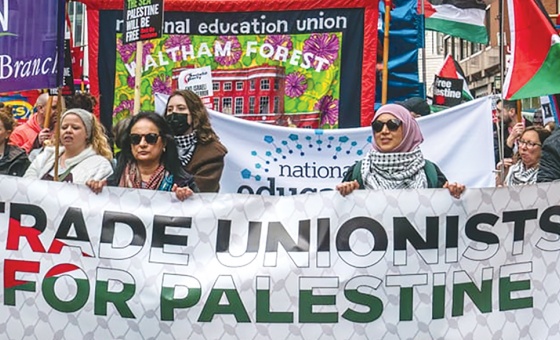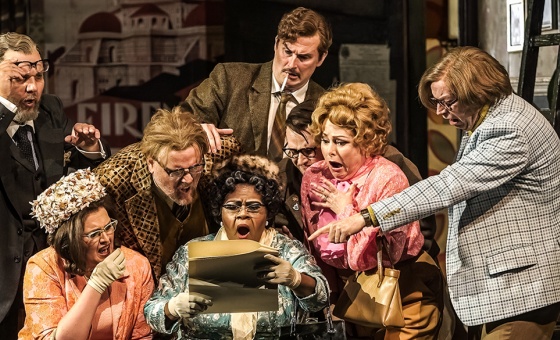This is the last article you can read this month
You can read more article this month
You can read more articles this month
Sorry your limit is up for this month
Reset on:
Please help support the Morning Star by subscribing here
UPRISING tells the stories of black pioneers — the people of “global majority heritage” who have helped shape Britain’s labour movement from its infancy.
This first-of-its-kind book produced by the GMB, edited by the union’s first national race organiser Tyehimba Nosakhere and John Callow, brings together chapter-length biographies and autobiographies of these trailblazers — from the cabinet-maker and revolutionary William Davidson, executed and buried in an unmarked grave in 1820, to activists at the forefront of organising workers today like Elaine Daley and Robbie Scott.
It’s an accessible and fascinating read, but what does Nosakhere hope people will get out of it?
“Appreciation of the contribution made by global majority heritage people historically.
“When you talk about race, it’s often about people who came from somewhere else and then struggle to assimilate or be integrated, but they aren’t clearly seen as having themselves been instrumental in the [labour movement’s] struggle — making a contribution along with other workers fighting the oppression capitalism imposes on us.
“We are threaded into the tapestry of working-class resistance and progress, which is crucial.”
It’s also about building a class consciousness “that reaches beyond skin, beyond unique characteristics.
“I hope global majority heritage people can gain inspiration from seeing how strong that thread is that is woven through our history, but also how our struggle for race equality has not blinkered us to the struggles against other inequality and oppression. We have been about the equality of all, and that’s important for understanding the need to reach out to each other, to band together.”
There is plenty to inspire in the book — but there are dispiriting episodes too, battles that end in defeat, and sometimes through betrayal or at least a lack of solidarity from other trade unionists — one such bitter episode being the chapter on Jayaben Desai and the Grunwick dispute.
It draws out a context in which the movement’s failings were as much about failure to recognise a new ruthlessness and determination by employers, from the late 1970s, to smash unions, as from conscious betrayal of the Grunwick strike, which in any case was by no means universal — the active solidarity of the miners, grassroots Apex activists and postal workers is highlighted.
Nosakhere’s own appointment as national race organiser reflects the fact that unions still have work to do on race, but have things improved?
“We have more of an ability to access information and connect with each other.
“There’s a running theme in the book that we need to stop being surprised or shocked at the brutality of the system, and look at ourselves to see the strength, the solidarity based in having an understanding of all workers and the factors that affect all workers.
“We then begin to appreciate the typical way in which racial division is perpetrated and maintained — and reach above the barriers that have been put up by structural, institutional, systematic racism. And when I say that I mean global majority heritage people like myself, but also our counterparts.
“Where are we at the moment? I don’t think we have sufficient connectivity to be a movement that does that. What we have are beacons of hope, individuals who are bright, powerful sparks who could ignite this.
“The role of people like myself and others with this privilege is to connect those inspiring dots, so we begin to surge.”
So he sees the key role of the national race organiser position as building unity among all workers “on the basis of a progressive consciousness that turns consciousness into action, collective action.”
A powerful scene from Nosakhere’s own autobiographical chapter relates his despatch to speak to a group of couriers in Ashby de la Zouch in Leicestershire, who had expressed interest in joining GMB.
He recalls the stares of “30-40 men, all white … who clearly had not expected a union officer to look the way that I did.”
He wins them to the benefits of the union through staying calm, confident and professional, demonstrating he is on top of their problems and explaining what union membership would do to help.
“I felt that I had fought the stereotypes that make racism possible and fundamentally changed the perspectives of people who had probably never talked to a black person before, much less sought their help and advice.”
It’s been said that trade unions are the best schools of anti-racism, because unity against an employer develops an understanding of our common interests as a class. Is this an example of that?
“I agree with that in principle. I don’t think we do enough of it.
“We have this way of assuming that we’ve become politically conscious just through the process of being in the union. It may have been like that once upon a time.
“But in recent years — and the book pulls this out, John [Callow’s] brilliant at weaving this in — we’ve lost that, we’ve become kind of mechanical.” Nosakhere says this means trade unionists can miss the connection between their day-to-day struggles and the global picture of working-class oppression under capitalism.
“Capitalism doesn’t just strike in one place. It’s like a hydra, it’s everywhere, and in order to combat that, there has to be a spirit, you have to awaken the soul.”
It’s no coincidence that some of the most famous anti-racists, from Martin Luther King to Nelson Mandela, were implacable opponents of capitalism, something often erased from their modern images.
“I don’t think you can separate [capitalism and racism]. Capitalism utilises division.”
Overcoming racial divisions is in this understanding integral to working-class advance. “How we create that bond between people, overcoming the barriers of language and culture, which is so necessary when we lead workers into struggle?”
Two reports loom large in the book — the Dr Elizabeth Henry report on racism in the union, buried for 20 years but to whose recent resurrection we owe the creation of the national race organiser post; and the famous report by Karon Monaghan KC into misogyny and sexual harassment in the union, following the abrupt downfall of its former leader Tim Roache.
The book carries many women’s voices, and Nosakhere says not only are the struggles against misogyny and racism interlinked, but that the union would have been unlikely to act in the way it is now doing on race had it not been for the Monaghan report.
“Monaghan was instrumental in, say, tweaking the conscience of this organisation.”
Having exposed “the sorry situation that existed for women in the organisation, we asked can we press forward without recognising that there is a massive issue in terms of race — and that the blueprint on what we needed to do was already there, it had just not been addressed.”
The GMB has an opportunity to lead because of the make-up of its membership, he believes, with the union representing many of the most exploited workers in the economy, cleaners and porters and caterers and couriers, Amazon warehouse staff.
“We represent those people working in all these industries that are essential for the country to work. And who is doing that work? Increasingly global majority heritage people, but also the poorest of the poorest white people.
“If we do not band together we will constantly be fighting little battles rather than winning the big war against capitalism.”
The book is available for £12.99 plus postage from GMB’s office at 542 Woodborough Road, Nottingham NG3 5FJ. Also available at Bookmarks bookshop, 1 Bloomsbury St, London WC1B 3QE.










